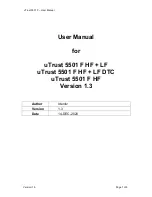
Page | 8
3.3.
Connecting to Power
The PiP is powered through the USB port.
3.4.
Communication via USB
The PID is 4480 (hex) and the VID is 0ACD (hex).
3.5.
Connecting to the Data Port
The PiP transfers data via the USB connector.
3.6.
Using the PiP for Value-Added Services
This tests the PiP’s ability to read an NFC phone or closed-loop tap card.
3.7.
Making a VAS Transaction
The PiP allows for customer loyalty program services using Contactless (NFC) technology. To make a
VAS transaction:
1.
Present the phone in close proximity to the front portion of the PiP.
2.
Orient the phone so that maximum surface area is parallel to the PiP.
3.
The phone used for the test should display a rewards screen (steps for using that screen depend
on the phone platform).
4.
The PiP beeps once to indicate a successful VAS transaction.
3.8.
Notes on Installation Locations
•
The PiP is designed to be mounted on a surface and in close proximity to any internal motors and
electrical devices that may be operating inside a point of sale area. However, the PiP is
susceptible to RF and electromagnetic interference. It is important that the unit not be mounted
near (within 3 or 4 feet) large electric motors, computer UPS systems, microwave transmitters
(Wi-Fi routers), anti-theft devices, radio transmitters, communications equipment and so on.
•
Tie all cables neatly with nylon cable-ties and route them so that they are inaccessible and
invisible to customers.
•
Test the PiP installation using a test card to perform an end-to-end VAS transaction. Even if the
transaction is declined (as it should be with a test card), it will prove connectivity all the way
through the system. If possible, a manager or some other responsible party should test each PiP
on a regular basis (perhaps at the start of each day or at least once per week) with a test card to
ensure continued operation and functionality. If the PiP is rebooted on a regular basis (such as
every night), it is important to test the contactless reader as soon as possible afterwards to
ensure continued communication to the PiP host.






























